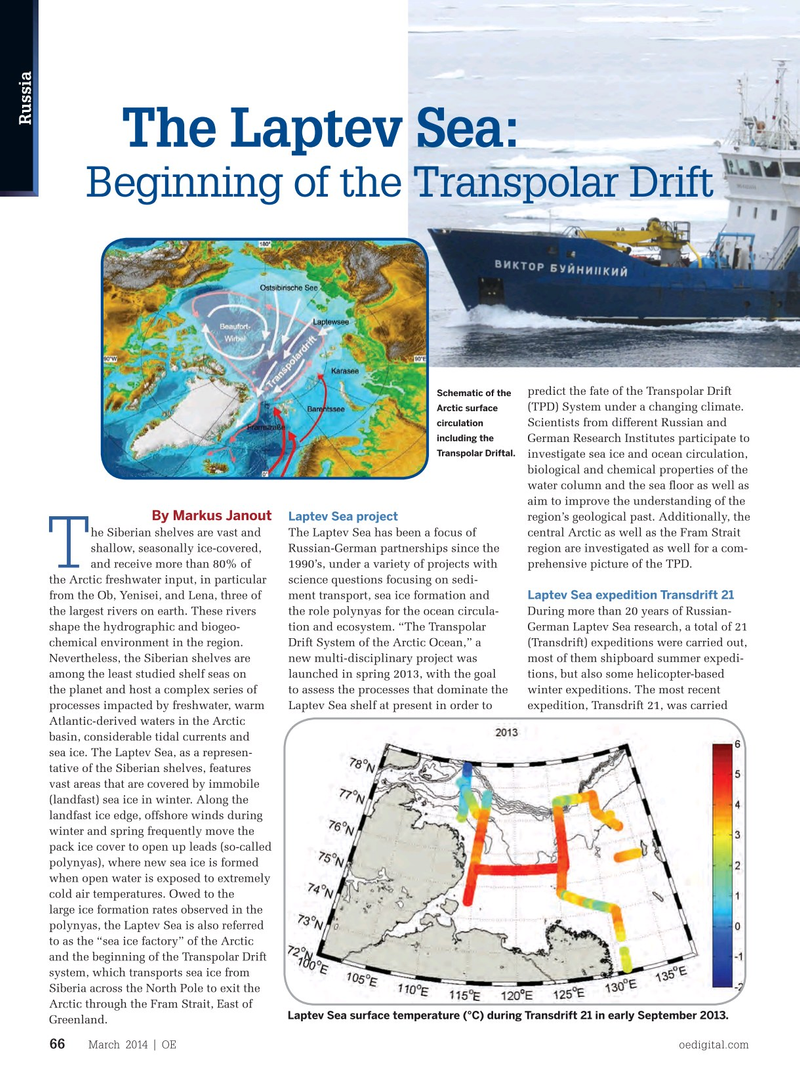
Page 64: of Offshore Engineer Magazine (Mar/Apr 2014)
Read this page in Pdf, Flash or Html5 edition of Mar/Apr 2014 Offshore Engineer Magazine
Russia
The Laptev Sea:
Beginning of the Transpolar Drift out August-September 2013 aboard the predict the fate of the Transpolar Drift
Schematic of the ~50m-long Russian-fagged vessel Viktor (TPD) System under a changing climate.
Arctic surface circulation
Buynitskiy. The science party boarded
Scientists from different Russian and including the the ship in Arkhangelsk and sailed
German Research Institutes participate to
Transpolar Driftal.
along the Northern Sea Route across the investigate sea ice and ocean circulation,
Barents and Kara Seas into the Laptev biological and chemical properties of the
Sea. As was often the case in the recent water column and the sea foor as well as years, the passage was largely ice-free, aim to improve the understanding of the
By Markus Janout
Laptev Sea project except a small region in Vilkitsky Strait, a region’s geological past. Additionally, the he Siberian shelves are vast and narrowing passage between the Kara and
The Laptev Sea has been a focus of central Arctic as well as the Fram Strait
Russian-German partnerships since the region are investigated as well for a com- shallow, seasonally ice-covered, Laptev Seas. The expedition was guided
T 1990’s, under a variety of projects with prehensive picture of the TPD.
and receive more than 80% of into the study region through the Strait science questions focusing on sedi- the Arctic freshwater input, in particular in a convoy of four vessels, lead by the
Laptev Sea expedition Transdrift 21 ment transport, sea ice formation and from the Ob, Yenisei, and Lena, three of Russian nuclear icebreaker Yamal.
the role polynyas for the ocean circula- the largest rivers on earth. These rivers During more than 20 years of Russian- The Laptev Sea shelf features extreme tion and ecosystem. “The Transpolar shape the hydrographic and biogeo- German Laptev Sea research, a total of 21 fronts and gradients between the differ- chemical environment in the region. (Transdrift) expeditions were carried out, ent water masses that are characterized
Drift System of the Arctic Ocean,” a new multi-disciplinary project was
Nevertheless, the Siberian shelves are most of them shipboard summer expedi- by the Lena River outfow and the warm among the least studied shelf seas on tions, but also some helicopter-based and saline water masses that are found launched in spring 2013, with the goal to assess the processes that dominate the the planet and host a complex series of winter expeditions. The most recent offshore along the continental slope. processes impacted by freshwater, warm expedition, Transdrift 21, was carried The different water masses are not only
Laptev Sea shelf at present in order to
Atlantic-derived waters in the Arctic basin, considerable tidal currents and sea ice. The Laptev Sea, as a represen- tative of the Siberian shelves, features vast areas that are covered by immobile (landfast) sea ice in winter. Along the landfast ice edge, offshore winds during winter and spring frequently move the pack ice cover to open up leads (so-called polynyas), where new sea ice is formed when open water is exposed to extremely cold air temperatures. Owed to the large ice formation rates observed in the polynyas, the Laptev Sea is also referred to as the “sea ice factory” of the Arctic and the beginning of the Transpolar Drift system, which transports sea ice from
Siberia across the North Pole to exit the
Arctic through the Fram Strait, East of
Laptev Sea surface temperature (°C) during Transdrift 21 in early September 2013.
Greenland.
March 2014 | OE oedigital.com 66 066_OE0314_Geofocus4_LaptevSea.indd 66 2/21/14 1:24 PM

 63
63

 65
65